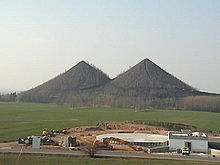Kegelberg

A cone mountain is a mountain with a pronounced cone shape . Kegelbergs are mostly isolated or only at the foot of other mountains. They are often of volcanic origin.
Cone peaks can have different shapes and are not necessarily geometrically shaped cones, they can also be tower-shaped or have a kink in the flank. Ideally, however, they have a circular base with even slopes of up to over 30 °. Typical cone mountains can be found in all volcanically shaped areas of the world, such as the Bohemian Central Mountains , the Rhön or the French Massif Central .
term
The cone mountain as a geomorphological term was coined by Goethe and geologists of his time. They were guided by their observations of nature, mostly basaltic or phonolithic masses in the form of a mathematical cone. This is how the term found its way into the early geological literature.
The first systematic geological mapping of the Kingdom of Saxony, suggested and begun by Abraham Gottlob Werner , describes numerous mountains of volcanic or sub-volcanic origin as cones and cone mountains in later works . Specifically, Carl Friedrich Naumann explains in the explanations of Section VII of the geognostic chart of the Kingdom of Saxony and the adjoining state divisions : The usual shape of the basalt and phonolite mountains is generally so wonderfully uniform that one can often see them from a great distance. They are cones. There are of course many deviations from this normal form; the round base stretches in length, the tip is shaped like a ridge or ridge, ... but most of the shapes can at least be traced back to the cone or spherical segment shape. ... Flat ridges are then lined up, from which only single, completely independent, basalt or phonolite cones rise.
In this work, which was created by Naumann and edited by Bernhard Cotta , the most important elevations in the area of the map sheet described are listed, for example: 33. The Mittenberg , a cone mountain in the middle between Tollenstein , Schönfeld and Neuhütte; Coarsely chipped rock with gray feldspar crystals.
Today, cone or cone mountain is mainly used as a morphological term in geography for a steep individual mountain, because geology does not only consider and describe cone mountains in connection with volcanic formation processes.
Formation types
Volcanic cone

All stratovolcanoes and also shield volcanoes have the tendency to form cones on the surface. The stratovolcanoes can form the steeper flanks, whereas the shield volcanoes can only form very flat cones. This is because in the stratovolcano the solid ejection material is mainly responsible for building the mountain, while in the shield volcano the liquid material is more responsible for building the mountain.
If the volcanic cone is built up mainly from ejected, pyroclastic material, cinder and ash cones are created that are usually only a few hundred meters high.
In the course of time after several eruptions, a cone of heap with the excavated material forms. As a result, the ejection is deposited around the crater in a radially decreasing manner. A thicker layer is deposited near the volcano than away from it, so the volcano grows faster near the crater. The slope is dependent on both the angle of friction with which the mountain is built and the weathering speed with which the mountain is removed. The angle of friction is also dependent on the composition of the lava , its viscosity and solidification speed, as well as the amount of loose material ejected. Many volcanoes tend to have side craters. New ejection openings are formed on the flanks, which means that new material is only applied to the mountain on one side. As a result, these mountains no longer have an ideal cone shape. An almost conical mountain can only be formed with stable central craters. Many volcanoes are therefore geometrical cones only when viewed from one direction, while when viewed from the side they have a more irregular shape or can be bulges.
Karst cone

Conical mountains can also form in the tropical karst . A typical example of non-volcanic cone mountains are the Chocolate Hills in Bohol in the Philippines .
Erosion as the cause
In almost all mountain regions, erosion processes can also cause conical mountains to form, but these are often not isolated. This is mostly due to a meandering river or a forced meander that has cut deep into a plateau. The surrounding mountains that arise in the process can be conical.
Artificial forms
Even artificially piled mountains and hills have a tendency to be conical. Such artificial mountains are also free-standing, and would meet the main requirement to be called a cone mountain. As artificial objects, however, they are considered heaps and not mountains.
See also
literature
- Carl Friedrich Naumann (Ed.), Bernhard Cotta (Ed.): Explanations of Section VII of the geognostic chart of the Kingdom of Saxony and the adjoining state departments or: Geognostic sketch of the areas between Schandau, Zittau, Kratzau, Gabel, Böhmisch-Leipe, Wernstadtel and Tetschen . Dresden and Leipzig (Arnoldische Buchhandlung) 1840
Web links
Individual evidence
- ↑ Naumann: Section VII, pp. 61-62
- ^ Naumann: Section VII, p. 94
- ↑ Hartmut Leser (Ed.): Diercke Dictionary General Geography. Munich (dtv) 2005, p. 421 ISBN 3-423-03422-X .
